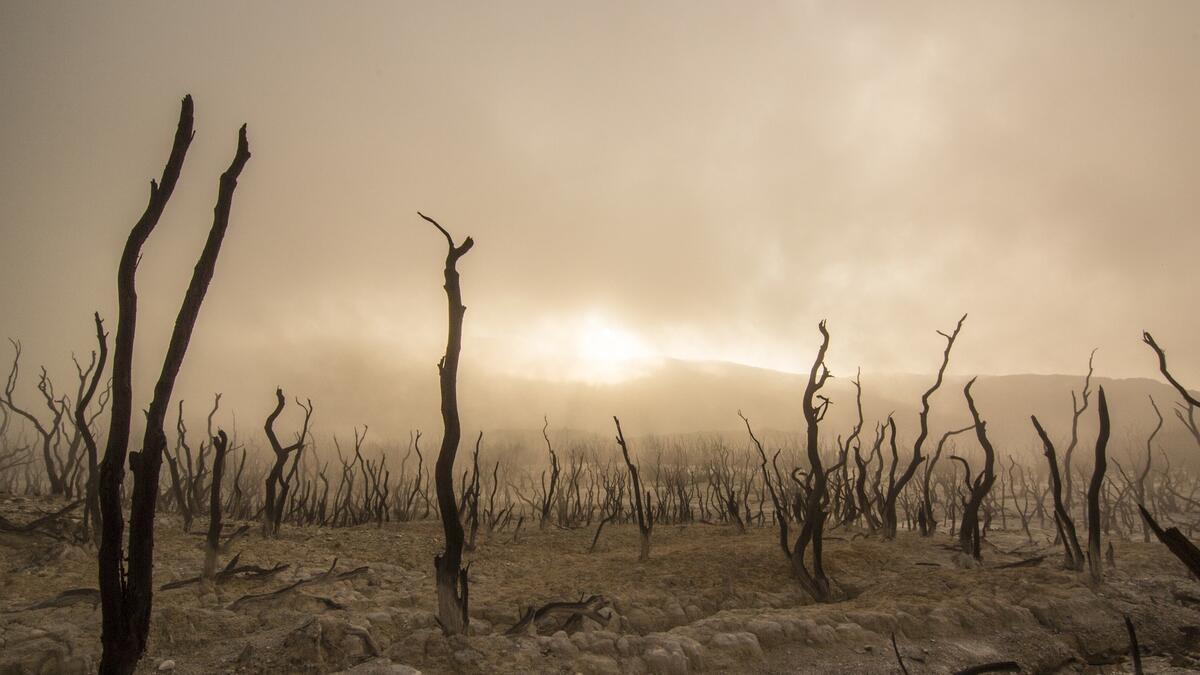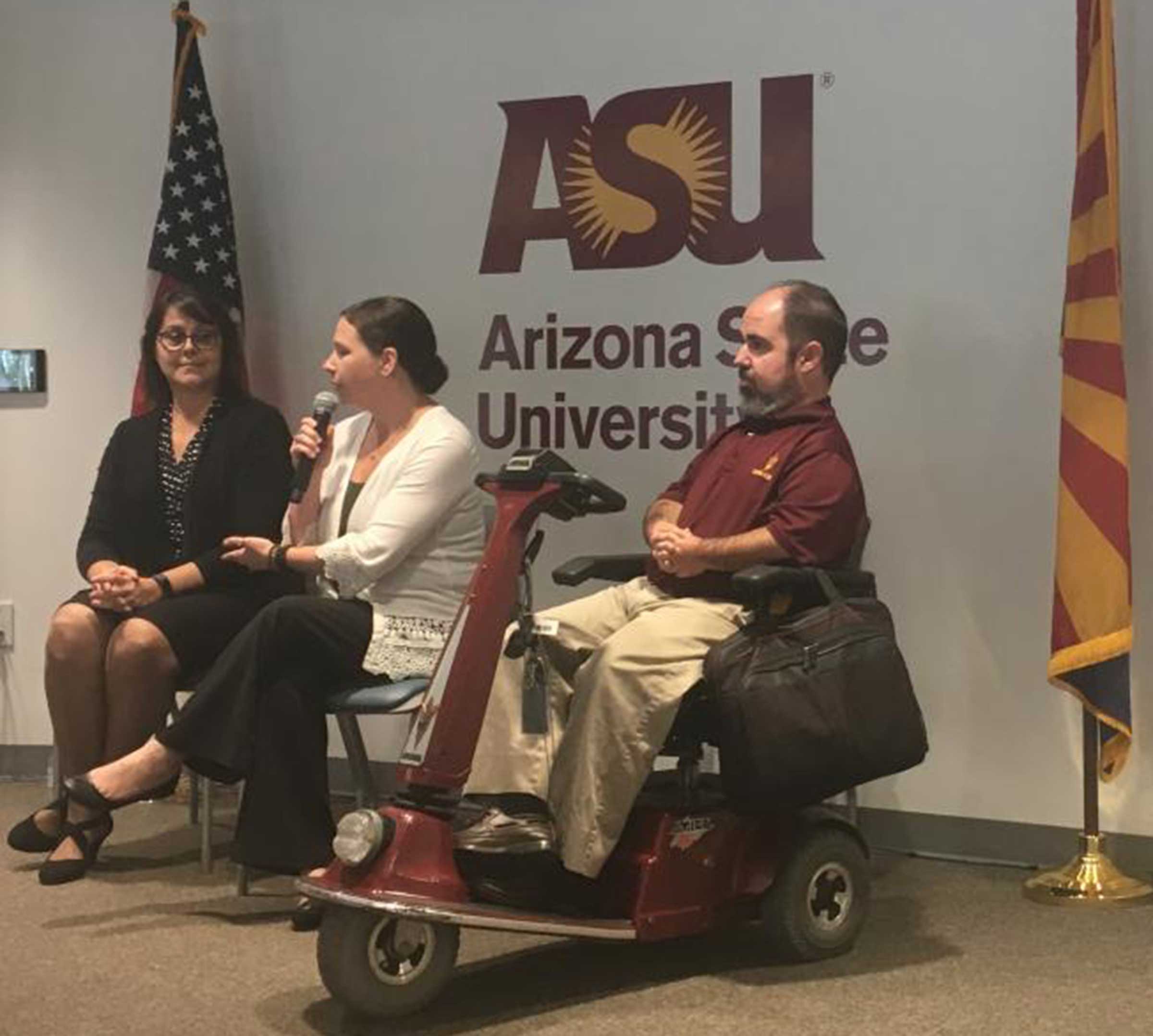A major earthquake that displaces a mass population of people. Widespread power outages that cascade through a metro area. Catastrophic droughts or devastating floods that strand people in their homes.
Natural disasters are an increasingly common reality for hundreds of thousands of Americans, and as climate change and urbanization amplify the frequency and intensity of these events, the response by communities, governments and private citizens is more important than ever before, according to Brian Gerber, co-director of Arizona State University's Center for Emergency Management and Homeland SecurityThe center is a research unit of the Watts College of Public Service and Community Solutions..
But academics, government agencies and volunteers are rising to the challenge — developing critical disaster responses, participating in full-scale exercises and harboring cross-sector partnerships for the inevitable day a disaster strikes.
Those partners came together Thursday at a Sustainability Series event titled "How Will Arizona Respond to a Major Regional Disaster?" The event was presented by the Julie Ann Wrigley Global Institute of Sustainability, the Center for Emergency Management and Homeland Security, the Lodestar Center for Philanthropy and Nonprofit Innovation and the Southwest Interdisciplinary Research Center.
Ramona Denby-Brinson, associate dean of research at the Watts College of Public Service and Community Solutions, spoke about how ASU's emergency management center is already making waves in the disaster response field, even though it was recently created.
“When I think about the Center for Emergency Management and Homeland Security, even in its infancy … it is already making inroads and really living out the true testament of what our vision is,” Denby-Brinson said.
The meeting, which featured a slate of speakers and a panel of experts in different facets of disaster response, came after the participation of the center and other state and community partners in a statewide “National Mass Care Exercise,” aimed at developing a better understanding of the role and capabilities of voluntary, private and governmental organizations in responding to a regional disaster in Arizona.
The exercise, which took place in May, focused on a mock scenario where a major earthquake in California causes an ingress of displaced citizens to flood into Arizona, straining law enforcement and emergency response, clogging traffic and putting strain on day-to-day private facilities.
It brought together a huge coalition of state, federal and local agencies — with private partners and nonprofit volunteers to emulate the scenario.
Speakers gave a brief overview of the tenets of the program, followed by a panel that discussed different facets of what a mass care response would look like in such a scenario.
(From left) Lori Cunningham, deputy administrator, Arizona Department of Economic Security; April Bradham, director of field operations, Association of Arizona Food Banks; and Peter Fischer, Americans with Disabilities Act coordinator for Phoenix. Photo by Isaac Windes/ASU Now
Peter Fischer, who works for the city of Phoenix as an Americans with Disabilities Act coordinator, discussed the steps required in preparing and executing accommodations for individuals with disabilities who were displaced in the scenario — as well as additional exercises to test and develop the city's disability integration capabilities.
“What I do ... is specifically for disability integration in the mass care exercise,” Fischer said. “The city did a bunch of different exercises outside of the national care exercise. … We opened a few shelters and tested that; we even had a drill at the airport for passengers who were stranded.”
In addition to the ordinary logistical problems associated with displacement, Fischer and other panelists stressed the importance and difficulty of communication between agencies, and with the public at large, during a disaster.
“The other issues we are really worried about is when we are having press conferences and we are having events … and these activities that are public knowledge — how are people with other disabilities being given that same information?”
April Bradham, director of field operations for the Association of Arizona Food Banks, talked about the importance of Voluntary Organizations Active in Disaster, or VOADs, in the larger statewide effort that would mobilize in the event of a disaster.
“Our VOAD in Arizona … is a range of organizations that are disaster-relief specific organizations like Red Cross, Salvation Army … and all these organizations that are actively involved in a task force,” Bradham said. "But then you also have this very large group of organizations that maybe disaster response isn’t even a piece of what they do, but they do support if a disaster was to occur. So, for example, our faith-based organizations that might provide spiritual care or volunteers, the emergency radio — so just a large mix of people.”
Arizona faces a particular challenge in preparing for a mass event like the one in the scenario because it does not often have to respond to natural disasters, unlike Texas and Florida that face a much higher frequency of mass care events.
“We aren’t necessarily activated at a state level very often,” Bradham said. “Our county and our local VOADs are the most critical piece of that because they are the ones that know the immediate needs, they’re the ones that know the immediate resources in the area.”
Bradham said that the biggest takeaway from the exercise was that Arizona could benefit from planning.
“I know it is easy to get a little bit apathetic because … we’re not faced with it every single day," she said.
Lori Cunningham, a deputy administrator at the Arizona Department of Economic Security, spoke about the issues that would arise and need to be prepared for.
"The Department of Economic Security was very fortunate particularly with this exercise because we served in multiple capacities, so from a response perspective we were able to work with the Red Cross and actually be in the shelters identifying folks with special needs,” Cunningham said. “Understanding reunification, I was able to lead the reunification task force … when families are separated, and when caregivers are separated from the folks who need them the most, how do we get those back together.”
Robert Rowley, director of the Maricopa County Department of Emergency Management and an ASU alumnus, spoke from the audience, pointing out that in the event of a mass care event, city and county officials don’t have reserve employees on hand to deal with such an influx.
“The biggest thing that we were thinking about during this process was, with the sheer number of people coming in, what realistically would we as local governments … be able to handle ourselves? And the answer is … not much,” Rowley said. “City and county governments operate with staff and materials sufficient to do their daily jobs. And we don’t maintain a reserve force of people that we can activate during a disaster to bring in and handle all this extra activity.”
The only government response that could do such a thing, Rowley said, is the military. But, “it’s about three days before federal resources, even the military, can be mobilized and in your area and starting to perform an operation.
“So what we have started looking at is what can we do for a period of three days, to take care of this massive influx of people.”
Rowley closed out some of his remarks with a statement that was echoed by many who participated in the program.
“That wasn’t answered by the end of the exercise,” Rowley said. “But the purpose of the exercise was to bring up those questions.”
Top photo courtesy of Pixabay
More Environment and sustainability

'Earth Day Amplified' promotes power of collective action
Everybody loves the concept of sustainability. They want to do their part, and the chance to say they’ve contributed to the well-being our of planet.But what does that actually mean?Arizona State…

Rethinking Water West conference explores sustainable solutions
How do you secure a future with clean, affordable water for fast-growing populations in places that are contending with unending drought, rising heat and a lot of outdated water supply infrastructure…
Meet the young students who designed an ocean-cleaning robot
A classroom in the middle of the Sonoran Desert might be the last place you’d expect to find ocean research — but that’s exactly what’s happening at Harvest Preparatory Academy in Yuma, Arizona.…



